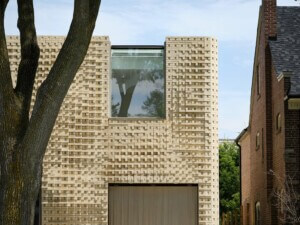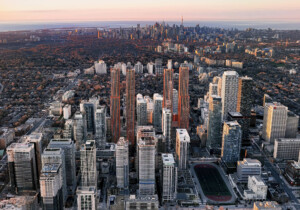While most people associate the beach with summer sun and fun, an annual staging of waterside installations in Toronto gives us a reason to visit the beach in the winter when the temperature drops and the gray skies roll in.
This year the Winter Stations international design competition returns to Toronto’s lakeshore for a temporary architecture exhibition intended to surprise and delight visitors in the coldest, most depressing months of the year. The ninth annual edition of Winter Stations welcomes five winning designs to Woodbine Beach alongside structures from student teams at three different Canadian universities. This year, one digital installation will join the IRL projects.
The hundreds of competition entrants were asked to respond to the theme of “radiance.” As far as installation design, almost anything goes, with the only parameter being that the structures incorporate the beach’s empty lifeguard chairs.
From opening day on February 20 though the end of March, the public will be able to get up close and personal with the interactive structures. In the spring, the Winter Stations will be re-installed in Sir Casmir Gzowski Park in Etobicoke’s Sunnyside neighbourhood.
Take a look below at the winning 2023 Winter Stations designs as well as three student projects. Project descriptions and images are provided by their respective designers.

CONRAD
Novak Djogo & Daniel Joshua Vanderhorst | Canada
“Conrad was the name of a raccoon that died on the corner of Yonge and Church in the summer of 2015. And though Conrad was just a raccoon, he was human enough to inspire compassion and warmth in the hearts of people across the GTA. This is a monument in his honour.”


the(Home)
Scott Shields Architects (Yulia Belova, Andrew Shields) | Canada
“With the world moving through major economic and political changes while still recovering from years of pandemic, we imagine the best manifestation of this year’s theme of radiance in a simple definition of “Home”. Home, whether it’s a space or beloved neighbourhood, is a place blessed, where one feels security, strength and freedom thus casting a radiance of inner beauty and potential to the outside world.
Playing with the idea of emitting and transmitting light, we introduce a simple shaped pavilion with carved bright-coloured walls to offer a constantly changing experience throughout day and night. While the dawn light shines through the colorful glass and letters creating a vivid kaleidoscope pattern, dusk brings a completely different experience with the light originating from within and spreading its sculptured glare to the outside. The red lifeguard tower stands in the center of the pavilion, resembling a person residing at homeplace.”

LIFE LINE
WeatherstonBruer Associates (James Bruer, Nick Roland, Jacqueline Hampshire) | Canada
“Radiance is a collective experience. The act of emitting and receiving positivity has an impact that reaches far beyond its origin point. LIFE LINE proposes an interactive station that materialises the transfer of joy through a shared, auditory experience.
LIFE LINE references the built infrastructure of the waterfront, the linear landscape of the beach and the distant horizon line. Participants can place a ball at the top of the tube, and send it rolling through a series of windchimes, creating a captivating soundscape for others to enjoy. Listening stations along the length of the tunnel project the sound outward and allow for multiple points of engagement. The experience of LIFE LINE is playful from near and far, and interprets radiance as joy that starts with the one person and radiates outward to many.”


3 Surfaces Pavilion
S-AR (César Guerrero, Ana Cecilia Garza, Orlando Garcia) | Mexico
“Three surfaces form this pavilion. The first, a pavement that marks the area on which the other two surfaces are placed. The other two surfaces, one smaller than the other, are curved pieces that take advantage of their shapes to structure itself and at the same time open up possibilities for inhabitability or programs. The user can gather around or inside the pavilion, stand, sit, or lie on the surfaces that call to be inhabited in very different ways.
The materials for the construction are very simple, modular metal frames that are covered with wooden boards. The wood gives texture to the elements, which is reinforced with bright yellow paint for the curved pieces and dark gray for the base or pavement of the pavilion. At the end of the life of the pavilion, the boards and wooden structure can be used to build other types of simple street furniture or boundaries for areas such as bridges, streets or gardens.”

delighthouse
Nick Green & Greig Pirrie | United Kingdom
“As though the winter sun has split through the prisms of an icy sky, rays of colour fold around a timber tower standing proudly in the distance. Inspired by lighthouses in coastal settings across Canada and beyond, delighthouse is a self-assured landmark guiding visitors to approach. While traditionally lighthouses are warnings, this installation is a welcoming beacon of hope, fun, energy, and pride. The confident and colourful pattern, evoking a sense of play, casts onto ground panels radiating out from the tower to embrace visitors.
Scaled to house the lifeguard stand, the tower is clad in painted timber boards. Structurally, eight tapered timber frames lean inwards, joined to form the tower, with strength derived from each part coming together as a whole.”


Ripple Hut
Cesar Rodriguez Perfetti, Jake Kroft, Breno Gualter, Dean Roumanis; lead by Associate Professor Vincent Hui, Toronto Metropolitan University Department of Architectural Science
“Canoes have been a fundamental method of transportation for thousands of years. They have contributed immensely to humanity’s growth, inner strength, and freedom. Ripple Hut emulates the form of aggregated canoes and offers an alternative approach to the beauty and craft of canoe fabrication. The structural connections of the pavilion depict ripples in the water. Small apertures in the framework of the pavilion will provide framed views of the surrounding context while the composition of the shells will protect visitors from the harsh winter conditions.
Radiance is expressed in the pavilion through form, materiality, and spatial interaction. Ripple Hut will be perceived differently in various contexts through haptics and the effect of light and shadow. The pavilion will serve as a place of convergence for visitors and will invite users to interact with its spatial and material conditions.”

We[AR]
Saina Amin, Craig Klomp, Lauren Mac Isaac, Catherine Yan (design team) and Mahmoud Afshari, Kaveh Eshraghian, Roozbeh Moayedian (tech team); lead by Assistant Professor Afshin Asari, University of Guelph, School of Environmental Design & Rural Development
“We[AR] encourages connection, humanism, and the strength of living in community by demonstrating the power that can be achieved when a community pulls together. WE[AR] is an interactive virtual installation that considers the local and regional contexts in which it is shown to present social issues and it exemplifies the power of unity in the face of societal crises. Whether it is in Canada, the United States, Ukraine, Africa, Iran, Afghanistan or anywhere in the world it demonstrates the strength of solidarity in addressing social challenges. Human rights, women’s rights, LGBTQ2S+ rights, pay disparity, mental health, racial discrimination, and sexual violence are among the issues addressed.
WE[AR] stands for a worldwide movement of solidarity and unity, and it begs us all to shine our own light to these critical societal challenges. It encourages visitors to explore the installation at their own pace, striking up conversations with other visitors and, most importantly, becoming allies to these communities. As more individuals congregate and interact with the exhibit, it leads it to respond and strengthen its look.
Each member of any community, no matter how large or small, benefits from the presence of solidarity because it fosters a sense of shared purpose and responsibility among its members and encourages them to help one another in times of need. A shining example of justice, solidarity, and humanity may be achieved when we act as one.”

Winter-net
Chiun Lee, Diana Si, Justin Park, Razmik Garboushian, Likhita Varikuti, Simon Liao; supervised by David Correa, Fiona Lim Tung, University of Waterloo Department of Architecture
“Freshly fallen snow is typically seen as a white blank canvas waiting for humans and animals to leave their mark on it. Winter-net looks to utilize snow’s ability to stick to porous surfaces as an ink for creative expression. Radiating from a central lifeguard stand, a series of layered nets woven between a structure of wooden posts filter and catch snow and sand over time as they are carried along by the wind. This accumulation inhibits light filtration and creates distinct shadows. While walking through Winter-net, participants are encouraged to interact with the nets in a similar way by covering them with snow to create a variety of forms and light conditions throughout.”
Melissa Agostino, Michaela MacLeod, Mary-Margaret McMahon, Stefan Novakovic, and cochair Brad Bradford juried this year’s Winter Stations competition. Sponsors of the 2023 program include RAW Design, Brixen Developments and Mirabella Condominiums, Sali Tabacchi Branding & Design, Meevo Digital, and Micro Pro Sienna.











